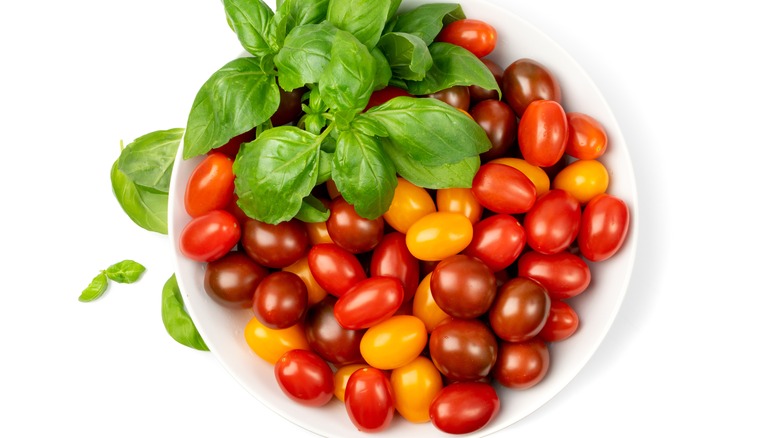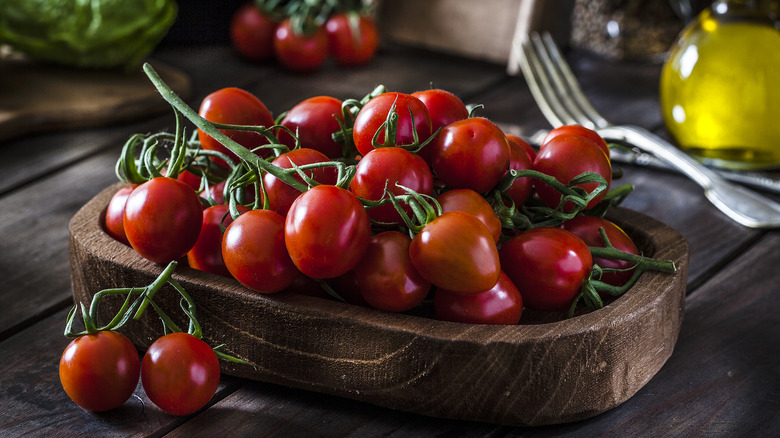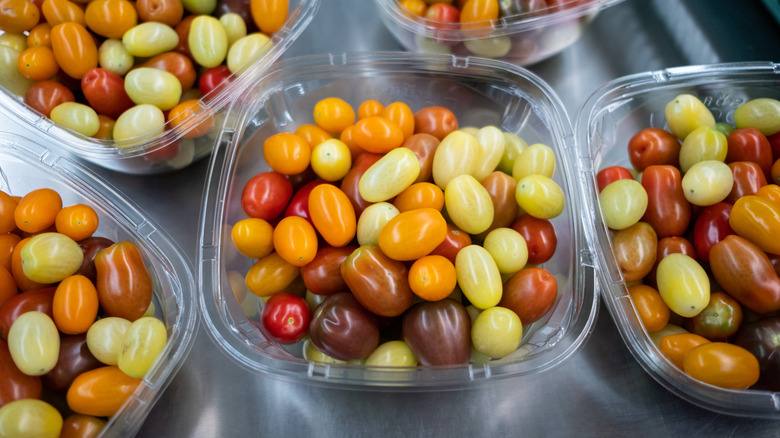No, Grape And Cherry Tomatoes Are Not The Same Thing
Some recipes will call for grape tomatoes, others will call for cherry tomatoes, and others still will say grape or cherry tomatoes. So when you're standing in the grocery store deciding what you're going to put in your cart, what do you choose? You could just go with whatever is on sale or catches your eye, or you could look at it critically: Which type will be better suited to your recipe? Because while they might be pretty interchangeable, no, they're not the same.
Let's break down the differences in shape, texture, and flavor. Cherry tomatoes are spherical, and grape tomatoes are oblong; cherry tomatoes are often (but not always) larger than grape tomatoes. If you have a massive grape tomato, it may actually be a plum tomato, whereas a seemingly overgrown cherry tomato might actually be a cocktail tomato. Cherry tomatoes are juicier. They have thinner skin, more tender flesh, and higher water content than the meatier, sturdier grape tomato. Cherry tomatoes, on average, are also typically a little sweeter, while grape tomatoes skew a little more savory.
As far as storage goes, cherry tomatoes have a shorter shelf life than grape tomatoes, so if you're not planning on using them up right away, you may want to opt for grape tomatoes. But other than those logistics, which ones should be used for which recipes?
The best ways to use cherry tomatoes
The best recipes to use cherry tomatoes in are going to highlight their delicate, juicy, sweet nature. They're excellent raw, marinated, or in super quick sauces that take advantage of their high water content rather than fight it.
They're really excellent in salads where their copious sweet tomato juice can mingle with the dressing or marinade, which is especially perfect for a fun take on a Caprese salad.
You can cook with them, too — they take really well to fast, high-heat situations where the sugars can start to caramelize a little. You can throw them on the grill for bruschetta, or you can roast them in a hot oven or even your air fryer to turn them into a smearable condiment or ready-to-toss pasta sauce. If you're going to top a savory tart, cherry tomatoes will bubble and cook a lot faster than grape tomatoes, so they'd be perfect for an easy weeknight puff pastry tart.
Because of their high water content and more scant flesh, they're not as good to use for longer-cooking dishes; once the water cooks out, you'll be left with little volume, so you'll need a much bigger haul to begin with than if you used grape tomatoes.
The best ways to use grape tomatoes
To be clear, grape tomatoes are also delicious raw; they're just less candy-like than cherry tomatoes. They have a more balanced acid-to-sugar ratio, making them comparatively more savory than cherry tomatoes. And as we mentioned, they're much better suited to longer cook times.
If you're going to stew tomatoes, we definitely recommend going for grape. They'll break down deliciously, but you won't lose as much volume because they're fleshier. And if you're putting them in the oven for any amount of time, they're probably your best bet. The trendy feta and tomato pasta, for example, sits in a 400 degree Fahrenheit oven for 35 minutes. You'll run a much higher risk of the tomatoes burning if you use juicy, delicate cherry tomatoes over fleshy, meaty grape tomatoes. And they're definitely what you want for a sheet-pan roast, which would happily accept a pint of grape tomatoes.
Regardless of which kind you choose, it can be really tedious to cut all those little tomatoes. Luckily, we have a hack for cutting tiny tomatoes, too. And as a final tip, always get one more container than you need for your recipe — if you're anything like us, you'll end up snacking as you prep.


